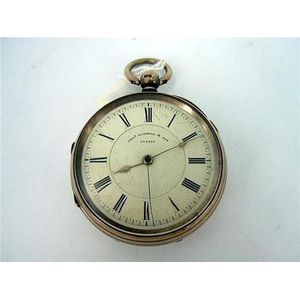Antique Sterling Silver Keywind Pocket Watch, James Mew London
You must be a subscriber, and be logged in to view price and dealer details.
Subscribe Now to view actual auction price for this item
When you subscribe, you have the option of setting the currency in which to display prices to $Au, $US, $NZ or Stg.
- Pair Cased - A pair cased watch is one with a double case. The movement is encased, and for additional protection this is fitted into an outer case.
- Filigree Work - Decorative Arts - Delicate decorations using fine threads of ceramics, glass or other materials to give a lace-like effect, attached together and applied as an ornament.
- Sterling Silver - Sterling silver is a mixture of 92.5% pure silver and 7.5% of another metal, usually copper. Fine silver is 99.9% pure silver, and is relatively soft and the addition of the very small amount of copper gives the metal enough strength and hardness to be worked into jewellery, decorative and household objects.
- Circa - A Latin term meaning 'about', often used in the antique trade to give an approximate date for the piece, usually considered to be five years on either side of the circa year. Thus, circa 1900 means the piece was made about 1900, probably between 1895 and 1905. The expression is sometimes abbreviated to c.1900.
- Fusee - The fusee movement was used in clocks and pocket watches from the mid 17th century. The fusee is a cone shaped drum within the works that is linked to the barrel of the spring, usually by a length of chain.
As the mainspring loses its tension over time, the cone shaped barrel compensates for this by increasing the tension, by pulling the mainspring tighter, thus ensuring the time remains constant.
Use of the fusee in clocks was superseded by the "going barrel" in the mid 19th century and for pocket watches at the beginning of the 19th century.
The fusee continued to be used in marine chronometers until the 1970s. - Movement - The technical name for the workings of a clock or watch, and does not include the dial or case.
This item has been included into following indexes:
-
pocket watches, case type
- enamelled decoration 161
- open face, silver case 570
- pair cased 165
- silver case 905
- pocket watches, period - Georgian 289
Visually similar items

A Victorian silver Consular cased pocket watch, 1859, hallmarked London with a fusee and chain drive lever movement by George border, Steaford. N.43840. Enamel dial in good order. Diameter 40 mm.

A silver centre seconds chronograph pocket watch. Case by James Neale, Chester, 1882. Weight: 151.3g

A silver chronograph pocket watch by Thomas Russell & Sons, Liverpool. 1901. Number 104204. Weight: 185.3g

A William IV silver consular case pocket watch by Jos Bates, Huddersfield, hallmarked London 1831. Fusee and chain drive movement. N.14214. Faint hairlines.
